ECO mode Acura TSX 2012 Owner's Manual
[x] Cancel search | Manufacturer: ACURA, Model Year: 2012, Model line: TSX, Model: Acura TSX 2012Pages: 324, PDF Size: 9.45 MB
Page 1 of 324
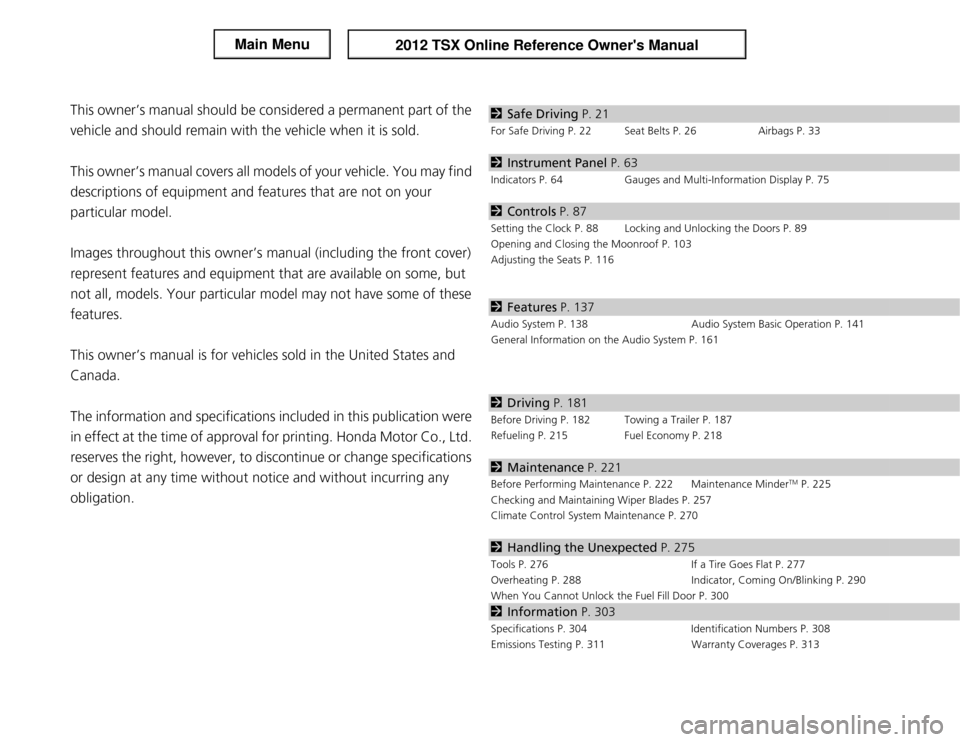
ContentsThis owner’s manual should be considered a permanent part of the
vehicle and should remain with the vehicle when it is sold.
This owner’s manual covers all models of your vehicle. You may find
descriptions of equipment and features that are not on your
particular model.
Images throughout this owner’s manual (including the front cover)
represent features and equipment that are available on some, but
not all, models. Your particular model may not have some of these
features.
This owner’s manual is for vehicles sold in the United States and
Canada.
The information and specifications included in this publication were
in effect at the time of approval for printing. Honda Motor Co., Ltd.
reserves the right, however, to discontinue or change specifications
or design at any time without notice and without incurring any
obligation.
2Safe Driving P. 21For Safe Driving P. 22 Seat Belts P. 26 Airbags P. 332Instrument Panel P. 63Indicators P. 64 Gauges and Multi-Information Display P. 752Controls P. 87Setting the Clock P. 88 Locking and Unlocking the Doors P. 89
Opening and Closing the Moonroof P. 103
Adjusting the Seats P. 1162Features P. 137Audio System P. 138 Audio System Basic Operation P. 141
General Information on the Audio System P. 1612Driving P. 181Before Driving P. 182 Towing a Trailer P. 187
Refueling P. 215 Fuel Economy P. 2182Maintenance P. 221Before Performing Maintenance P. 222 Maintenance Minder
TM P. 225
Checking and Maintaining Wiper Blades P. 257
Climate Control System Maintenance P. 270
2Handling the Unexpected P. 275Tools P. 276 If a Tire Goes Flat P. 277
Overheating P. 288 Indicator, Coming On/Blinking P. 290
When You Cannot Unlock the Fuel Fill Door P. 3002Information P. 303Specifications P. 304 Identification Numbers P. 308
Emissions Testing P. 311 Warranty Coverages P. 313
Page 15 of 324
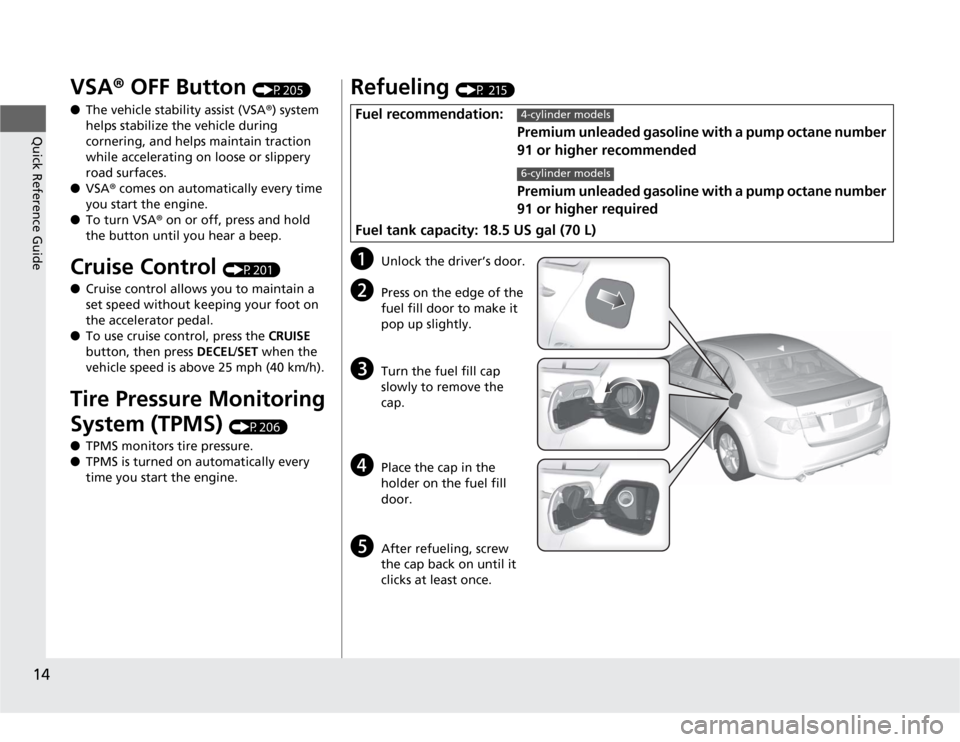
14Quick Reference Guide
VSA® OFF Button
(P205)
●The vehicle stability assist (VSA®) system
helps stabilize the vehicle during
cornering, and helps maintain traction
while accelerating on loose or slippery
road surfaces.
●VSA® comes on automatically every time
you start the engine.
●To turn VSA® on or off, press and hold
the button until you hear a beep.
Cruise Control
(P201)
●Cruise control allows you to maintain a
set speed without keeping your foot on
the accelerator pedal.
●To use cruise control, press the CRUISE
button, then press DECEL/SET when the
vehicle speed is above 25 mph (40 km/h).
Tire Pressure Monitoring
System (TPMS)
(P206)
●TPMS monitors tire pressure.
●TPMS is turned on automatically every
time you start the engine.
Refueling
(P 215)
a
Unlock the driver’s door.
b
Press on the edge of the
fuel fill door to make it
pop up slightly.
c
Turn the fuel fill cap
slowly to remove the
cap.
d
Place the cap in the
holder on the fuel fill
door.
e
After refueling, screw
the cap back on until it
clicks at least once.
Fuel recommendation:
Premium unleaded gasoline with a pump octane number
91 or higher recommended
Premium unleaded gasoline with a pump octane number
91 or higher required
Fuel tank capacity: 18.5 US gal (70 L)
4-cylinder models6-cylinder models
Page 19 of 324
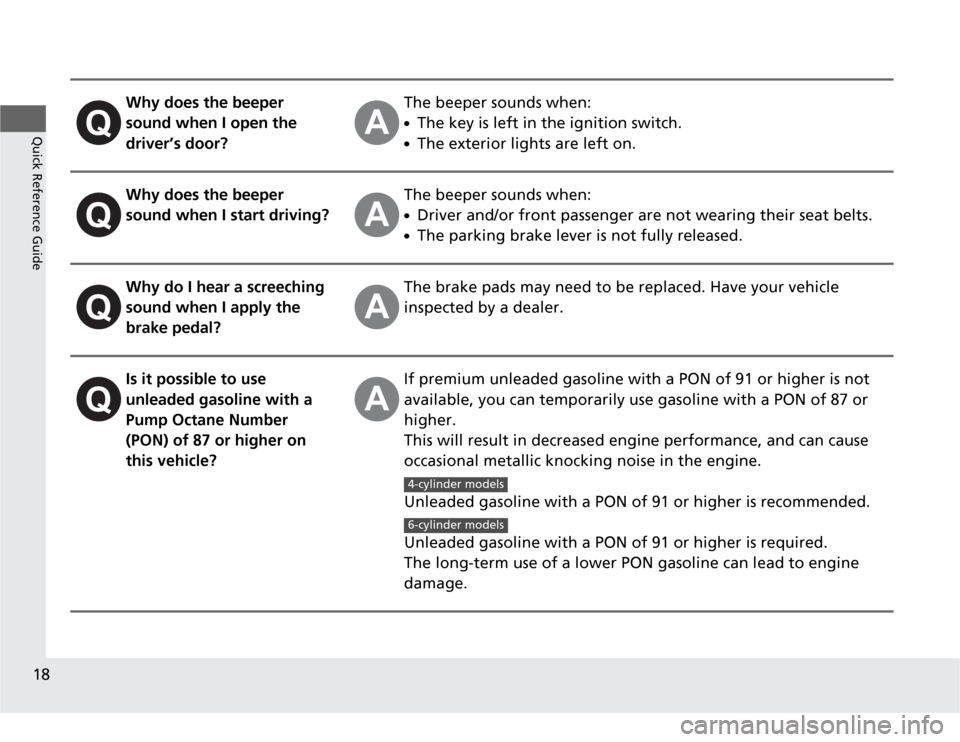
18Quick Reference Guide
Why does the beeper
sound when I open the
driver’s door?
The beeper sounds when:●
The key is left in the ignition switch.
●
The exterior lights are left on.
Why does the beeper
sound when I start driving?
The beeper sounds when:●
Driver and/or front passenger are not wearing their seat belts.
●
The parking brake lever is not fully released.
Why do I hear a screeching
sound when I apply the
brake pedal?
The brake pads may need to be replaced. Have your vehicle
inspected by a dealer.
Is it possible to use
unleaded gasoline with a
Pump Octane Number
(PON) of 87 or higher on
this vehicle?
If premium unleaded gasoline with a PON of 91 or higher is not
available, you can temporarily use gasoline with a PON of 87 or
higher.
This will result in decreased engine performance, and can cause
occasional metallic knocking noise in the engine.
Unleaded gasoline with a PON of 91 or higher is recommended.
Unleaded gasoline with a PON of 91 or higher is required.
The long-term use of a lower PON gasoline can lead to engine
damage.4-cylinder models6-cylinder models
Page 35 of 324

34
uuAirbagsuAirbag System Components
Safe Driving
The front, front side, and side curtain
airbags are deployed according to the
direction and severity of impact. The airbag
system includes:a
Two SRS (Supplemental Restraint System)
front airbags. The driver’s airbag is stored
in the center of the steering wheel; the
front passenger’s airbag is stored in the
dashboard. Both are marked SRS
AIRBAG.
b
Two side airbags, one for the driver and
one for a front passenger. The airbags are
stored in the outer edges of the seat-
backs. Both are marked SIDE AIRBAG.
c
Two side curtain airbags, one for each
side of the vehicle. The airbags are stored
in the ceiling, above the side windows.
The front and rear pillars are marked
SIDE CURTAIN AIRBAG.
d
An electronic control unit that continually
monitors and records information about
the sensors, the airbag activators, the
seat belt tensioners, and driver and front
passenger seat belt use when the ignition
switch is in ON
(w
.
e
Automatic front seat belt tensioners. The
driver’s and front passenger’s seat belts
incorporate sensors that detect whether
or not they are fastened.
f
A driver’s seat position sensor. If the seat
is too far forward, the airbag will inflate
with less force.
g
Weight sensors in the front passenger’s
seat. The front passenger’s airbag will be
turned off if the weight on the seat is 65
lbs (29 kg) or less (the weight of an infant
or small child).
h
Impact sensors that can detect a
moderate-to-severe front or side
collision.
i
An indicator on the dashboard that alerts
you that the front passenger’s front
airbag has been turned off.
j
Sensors that can detect if a child or small
statured adult is in the deployment path
of the front passenger’s side airbag.
k
An indicator on the instrument panel that
alerts you to a possible problem with your
airbag system or seat belt tensioners.
l
An indicator on the instrument panel that
alerts you that the front passenger’s side
airbag has been turned off.
m
Safing Sensor
Page 38 of 324
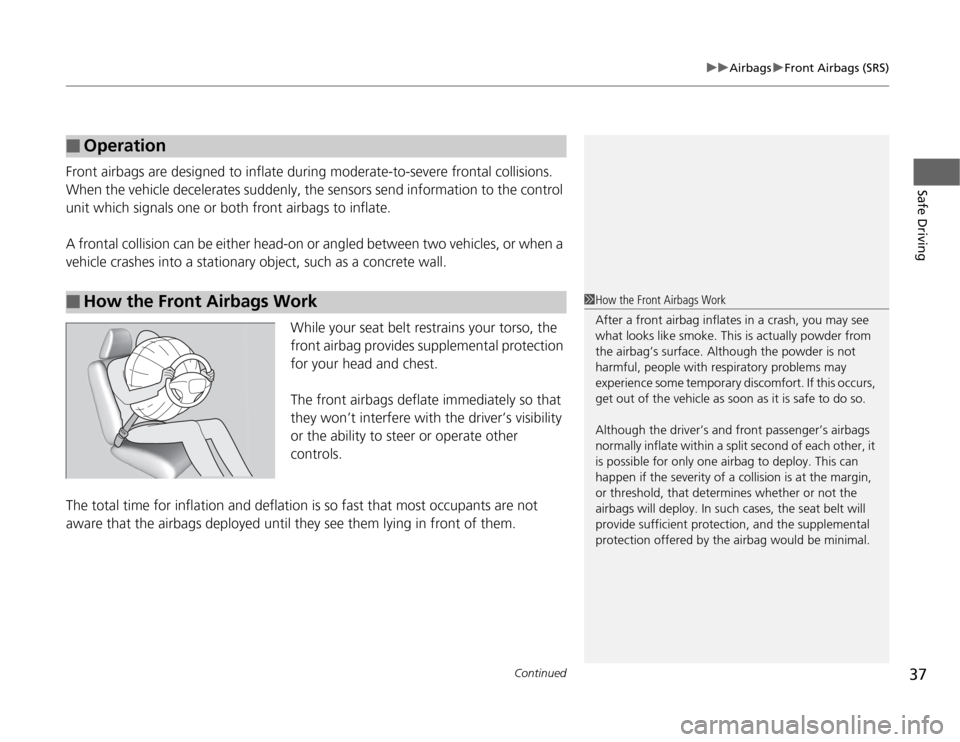
Continued
37
uuAirbagsuFront Airbags (SRS)
Safe Driving
Front airbags are designed to inflate during moderate-to-severe frontal collisions.
When the vehicle decelerates suddenly, the sensors send information to the control
unit which signals one or both front airbags to inflate.
A frontal collision can be either head-on or angled between two vehicles, or when a
vehicle crashes into a stationary object, such as a concrete wall.
While your seat belt restrains your torso, the
front airbag provides supplemental protection
for your head and chest.
The front airbags deflate immediately so that
they won’t interfere with the driver’s visibility
or the ability to steer or operate other
controls.
The total time for inflation and deflation is so fast that most occupants are not
aware that the airbags deployed until they see them lying in front of them.■
Operation
■
How the Front Airbags Work
1How the Front Airbags Work
After a front airbag inflates in a crash, you may see
what looks like smoke. This is actually powder from
the airbag’s surface. Although the powder is not
harmful, people with respiratory problems may
experience some temporary discomfort. If this occurs,
get out of the vehicle as soon as it is safe to do so.
Although the driver’s and front passenger’s airbags
normally inflate within a split second of each other, it
is possible for only one airbag to deploy. This can
happen if the severity of a collision is at the margin,
or threshold, that determines whether or not the
airbags will deploy. In such cases, the seat belt will
provide sufficient protection, and the supplemental
protection offered by the airbag would be minimal.
Page 48 of 324
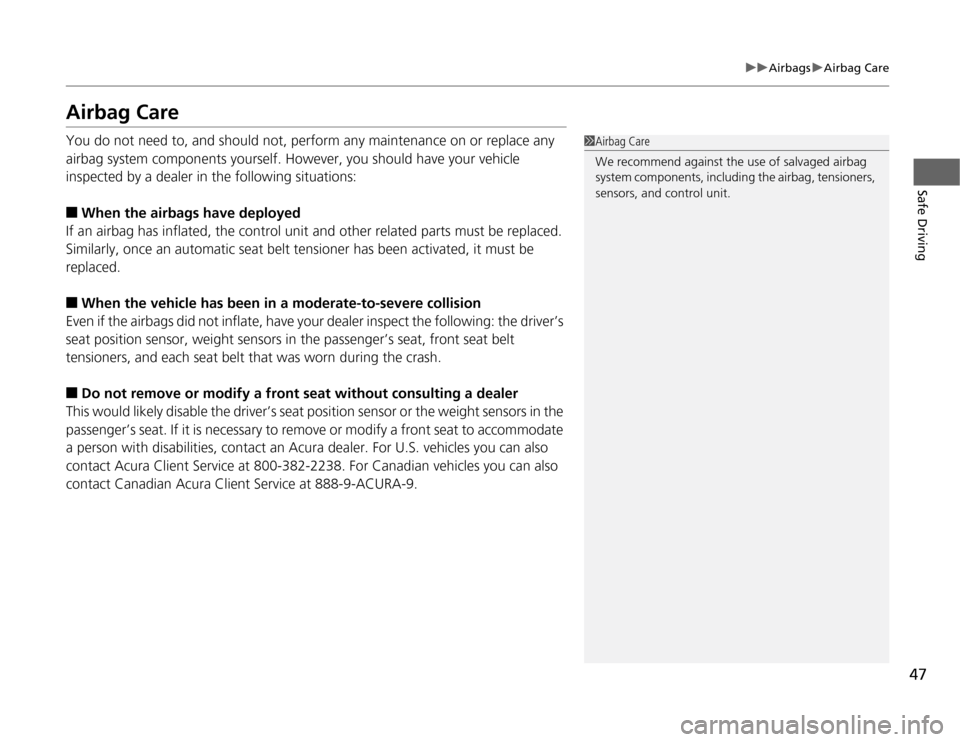
47
uuAirbagsuAirbag Care
Safe Driving
Airbag CareYou do not need to, and should not, perform any maintenance on or replace any
airbag system components yourself. However, you should have your vehicle
inspected by a dealer in the following situations:■
When the airbags have deployed
If an airbag has inflated, the control unit and other related parts must be replaced.
Similarly, once an automatic seat belt tensioner has been activated, it must be
replaced.
■
When the vehicle has been in a moderate-to-severe collision
Even if the airbags did not inflate, have your dealer inspect the following: the driver’s
seat position sensor, weight sensors in the passenger’s seat, front seat belt
tensioners, and each seat belt that was worn during the crash.
■
Do not remove or modify a front seat without consulting a dealer
This would likely disable the driver’s seat position sensor or the weight sensors in the
passenger’s seat. If it is necessary to remove or modify a front seat to accommodate
a person with disabilities, contact an Acura dealer. For U.S. vehicles you can also
contact Acura Client Service at 800-382-2238. For Canadian vehicles you can also
contact Canadian Acura Client Service at 888-9-ACURA-9.
1Airbag Care
We recommend against the use of salvaged airbag
system components, including the airbag, tensioners,
sensors, and control unit.
Page 62 of 324

61Safe Driving
Safety LabelsLabel LocationsThese labels are in the locations shown. They warn you of potential hazards that can cause serious injury or death. Read these labels
carefully.
If a label comes off or becomes hard to read (except for the U.S. dashboard label which may be removed by the owner), contact a dealer
for a replacement.
Sun Visor
U.S. models
Canadian models
Radiator CapDoorjambs
U.S. models U.S. models onlyDashboard
Canadian
models
Page 65 of 324
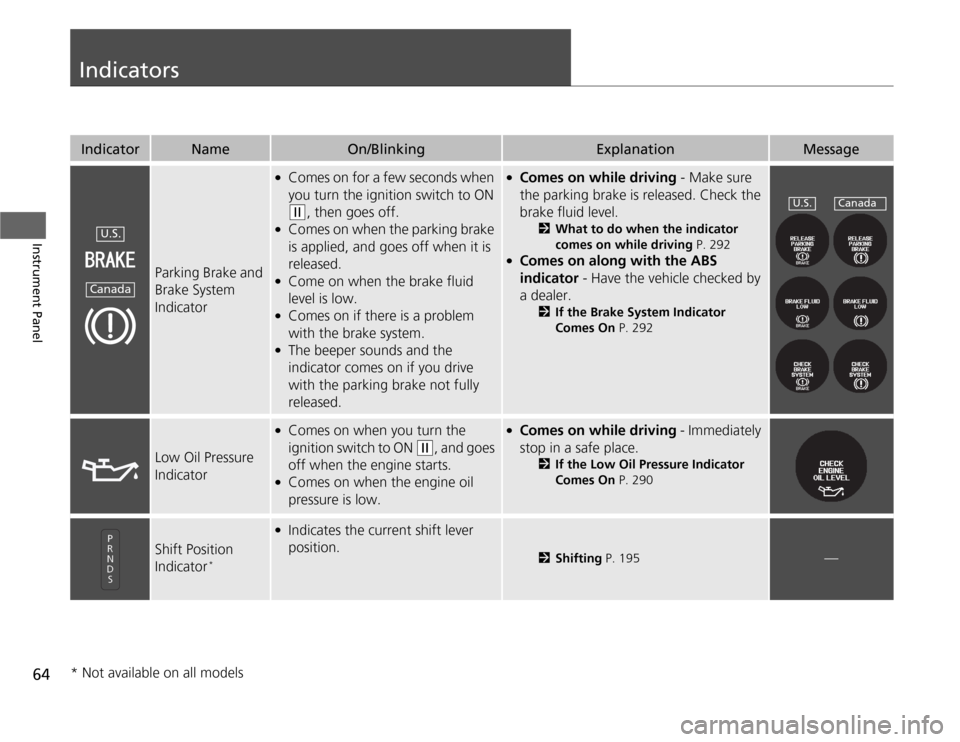
64Instrument Panel
IndicatorsIndicator
Name
On/Blinking
Explanation
Message
Parking Brake and
Brake System
Indicator
●
Comes on for a few seconds when
you turn the ignition switch to ON (w
, then goes off.
●
Comes on when the parking brake
is applied, and goes off when it is
released.
●
Come on when the brake fluid
level is low.
●
Comes on if there is a problem
with the brake system.
●
The beeper sounds and the
indicator comes on if you drive
with the parking brake not fully
released.
●
Comes on while driving - Make sure
the parking brake is released. Check the
brake fluid level.
2What to do when the indicator
comes on while driving P. 292
●
Comes on along with the ABS
indicator - Have the vehicle checked by
a dealer.
2If the Brake System Indicator
Comes On P. 292
Low Oil Pressure
Indicator
●
Comes on when you turn the
ignition switch to ON
(w
, and goes
off when the engine starts.
●
Comes on when the engine oil
pressure is low.
●
Comes on while driving - Immediately
stop in a safe place.
2If the Low Oil Pressure Indicator
Comes On P. 290
Shift Position
Indicator
*
●
Indicates the current shift lever
position.
2Shifting P. 195
—
U.S.Canada
U.S.
Canada
* Not available on all models
Page 66 of 324
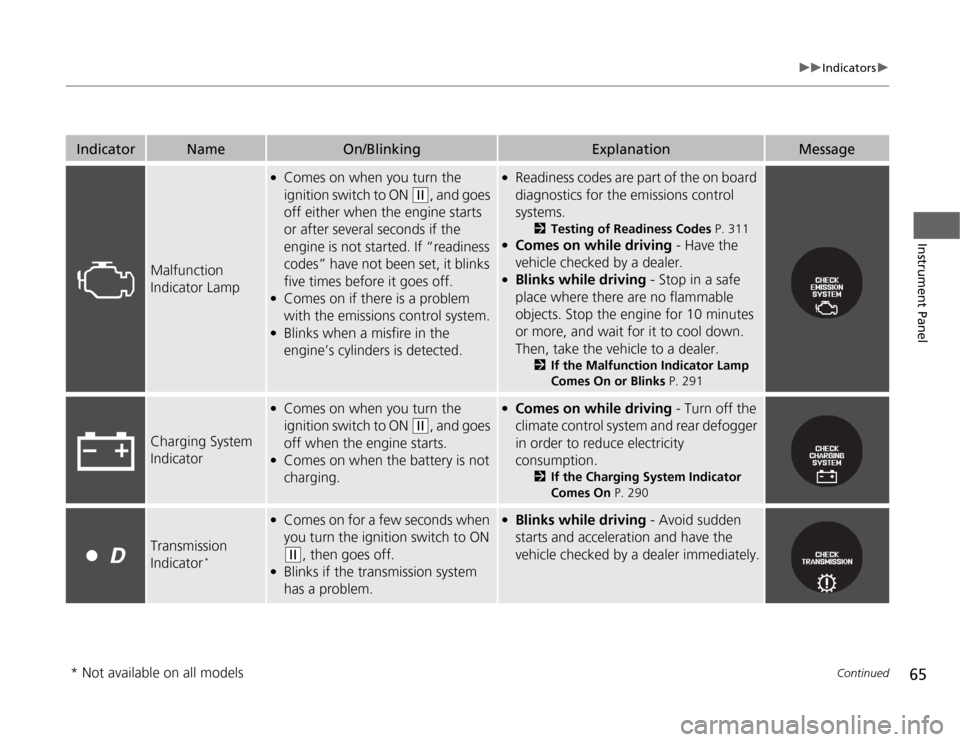
65
uuIndicatorsu
Continued
Instrument Panel
Indicator
Name
On/Blinking
Explanation
Message
Malfunction
Indicator Lamp
●
Comes on when you turn the
ignition switch to ON
(w
, and goes
off either when the engine starts
or after several seconds if the
engine is not started. If “readiness
codes” have not been set, it blinks
five times before it goes off.
●
Comes on if there is a problem
with the emissions control system.
●
Blinks when a misfire in the
engine’s cylinders is detected.
●
Readiness codes are part of the on board
diagnostics for the emissions control
systems.
2Testing of Readiness Codes P. 311
●
Comes on while driving - Have the
vehicle checked by a dealer.
●
Blinks while driving - Stop in a safe
place where there are no flammable
objects. Stop the engine for 10 minutes
or more, and wait for it to cool down.
Then, take the vehicle to a dealer.
2If the Malfunction Indicator Lamp
Comes On or Blinks P. 291
Charging System
Indicator
●
Comes on when you turn the
ignition switch to ON
(w
, and goes
off when the engine starts.
●
Comes on when the battery is not
charging.
●
Comes on while driving - Turn off the
climate control system and rear defogger
in order to reduce electricity
consumption.
2If the Charging System Indicator
Comes On P. 290
Transmission
Indicator
*
●
Comes on for a few seconds when
you turn the ignition switch to ON (w
, then goes off.
●
Blinks if the transmission system
has a problem.
●
Blinks while driving - Avoid sudden
starts and acceleration and have the
vehicle checked by a dealer immediately.
* Not available on all models
Page 67 of 324
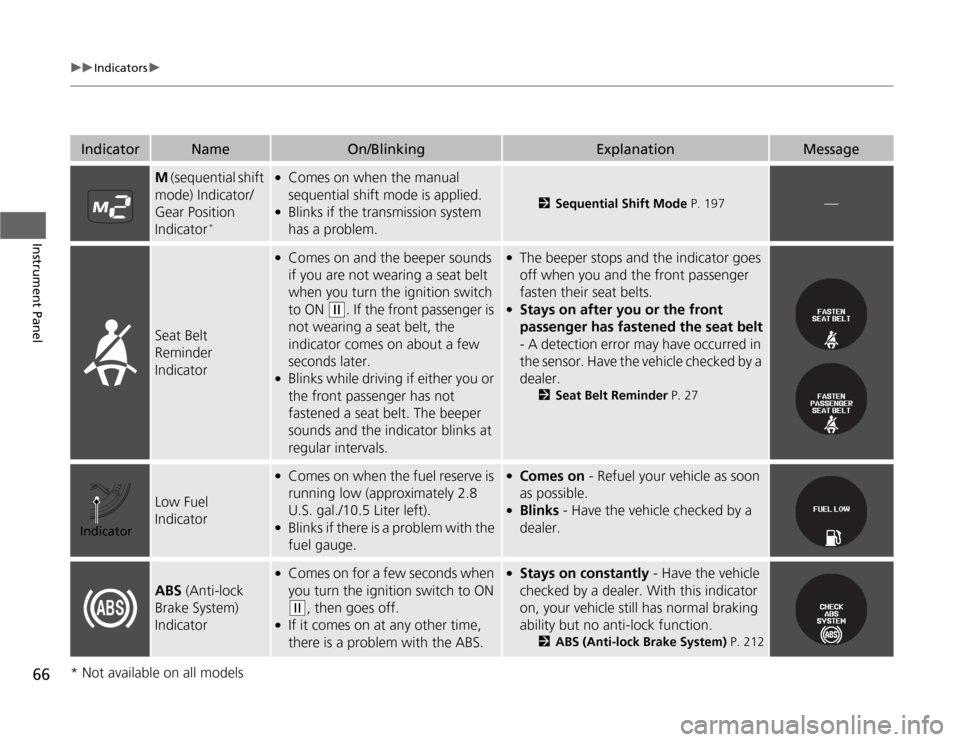
66
uuIndicatorsu
Instrument Panel
Indicator
Name
On/Blinking
Explanation
Message
M (sequential shift
mode) Indicator/
Gear Position
Indicator
*
●
Comes on when the manual
sequential shift mode is applied.
●
Blinks if the transmission system
has a problem.
2Sequential Shift Mode P. 197
—
Seat Belt
Reminder
Indicator
●
Comes on and the beeper sounds
if you are not wearing a seat belt
when you turn the ignition switch
to ON
(w
. If the front passenger is
not wearing a seat belt, the
indicator comes on about a few
seconds later.
●
Blinks while driving if either you or
the front passenger has not
fastened a seat belt. The beeper
sounds and the indicator blinks at
regular intervals.
●
The beeper stops and the indicator goes
off when you and the front passenger
fasten their seat belts.
●
Stays on after you or the front
passenger has fastened the seat belt
- A detection error may have occurred in
the sensor. Have the vehicle checked by a
dealer.
2Seat Belt Reminder P. 27
Low Fuel
Indicator
●
Comes on when the fuel reserve is
running low (approximately 2.8
U.S. gal./10.5 Liter left).
●
Blinks if there is a problem with the
fuel gauge.
●
Comes on - Refuel your vehicle as soon
as possible.
●
Blinks - Have the vehicle checked by a
dealer.
ABS (Anti-lock
Brake System)
Indicator
●
Comes on for a few seconds when
you turn the ignition switch to ON (w
, then goes off.
●
If it comes on at any other time,
there is a problem with the ABS.
●
Stays on constantly - Have the vehicle
checked by a dealer. With this indicator
on, your vehicle still has normal braking
ability but no anti-lock function.
2ABS (Anti-lock Brake System) P. 212
Indicator* Not available on all models